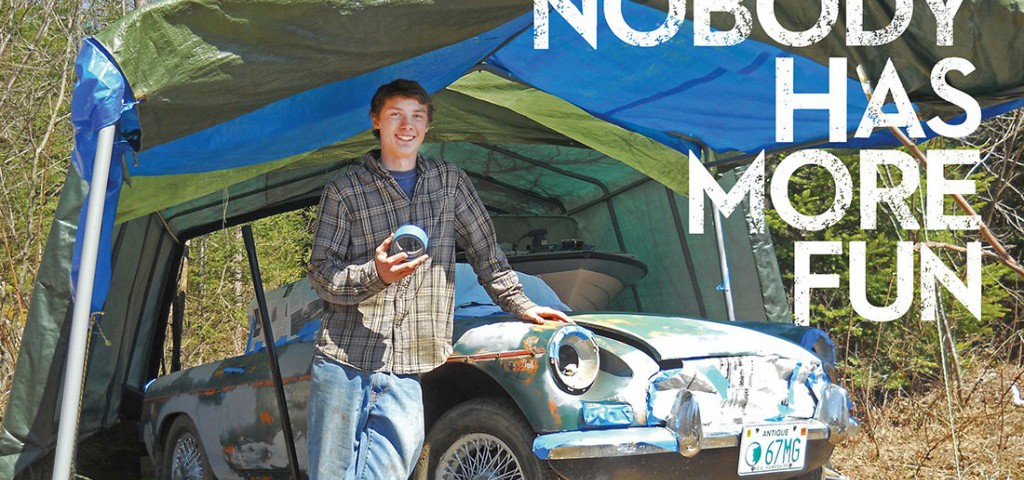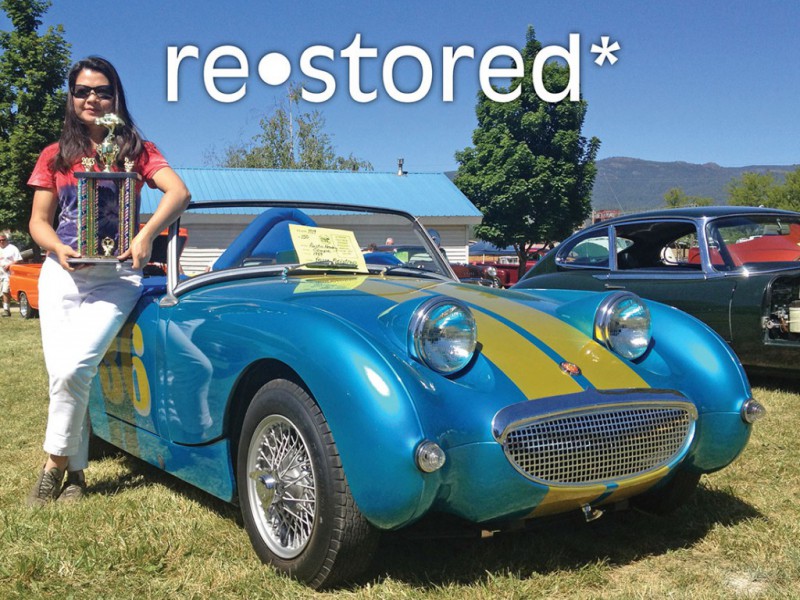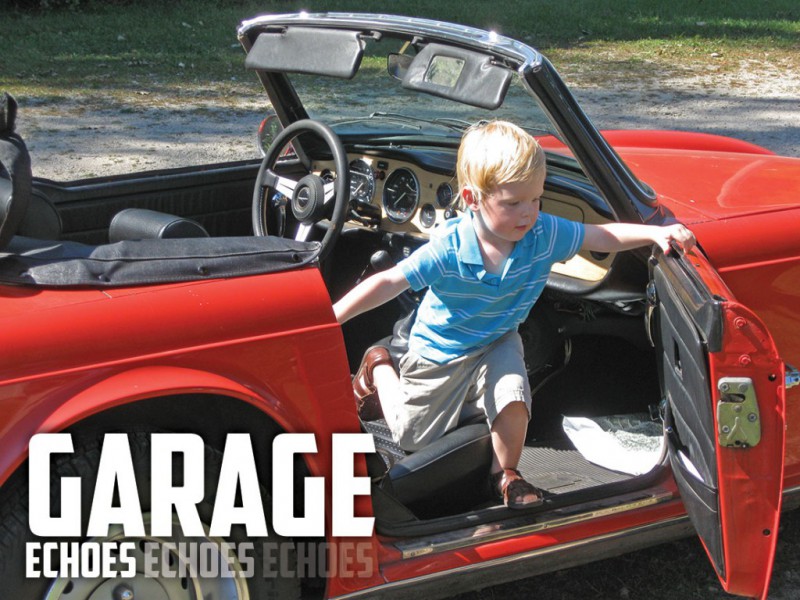When I bought my MGB, I knew just a fragment about the mechanical aspects of a car, but each day I would learn something new. One day it was how to set the gap on spark plugs and contact points. The next it was bleeding brakes and slave cylinders. By the time I had owned my MGB for a couple months, I replaced my clutch, valve gaskets, the steering column, and even rebuilt the generator. However, parts can be expensive, and for this reason “Necessity Before Accessory” is a phrase this high school student on a budget lives by. And Moss catalogs and Haynes repair manuals quickly became my New and Old Testaments.
Car painting is one of the hardest skills to master, and this spring, that’s just what my friend, Ian, and I tried to do. My MGB had worn four different colors over the years, starting out red in the sixties, switching to baby blue in the eighties, wearing rust orange in the nineties, then finally wearing a green coat of spray paint I had put on a year ago. However, this coat was put on quickly, and had already began to chip and fade. This spring my bank account had a slight surplus of money, but not enough for a professional job. So in one night, a whopping $140 was spent on two spray guns and a kit of British Racing Green single-stage urethane paint.
Sanding the car was the first step and, as I had only one orbital sander, Ian and I took turns sanding and removing the various chrome trim from the car. This was done without trouble, and we soon moved on to taping the remaining exposed portions of the car. Our main problem came when we bondoed the car. I had no idea how to bondo, but Ian said he had a little experience. We knelt in the grass in front of the shed, Ian mixing the bondo, explaining to me how to apply it to the car. It took about an hour and by the end the whole car was covered in the pink plaster.
The next morning, I returned to the car to a horrifying realization. The bondo was not hardening up at all. The plaster still glistened in the sun, and in one swipe, I could wipe it off with my finger. Instinctively, I ran inside, grabbed a sheetrock knife, and began scraping the pinkish gray goo off the body of my car. It was four in the afternoon before Ian and I could begin painting. We had spent the entirety of the day dealing with the sticky mess we had created the day before; but that was finally all behind us.
Painting with an air compressor was completely new to me, and adjusting the guns to the proper spray took a half hour by itself. Painting the car was monotonous; I only had a two-gallon air compressor. This made for a very long night, as I would spray the car for five or so seconds, then wait an additional twenty for the line to pressurize. Ian and I switched off, spraying the car then mixing more paint. My dad visited us frequently, giving us advice on how to get an even coat, examining our work. On our third trade off, the gun began to feel light. “I will check the level,” I thought, so with cold, trembling hands I unscrewed the cap, sending the remainder of the paint down my flannel shirt and worn out jeans. I stood speechless for a second, hands out in front of my chest, examining my new British Racing Green skin. I looked up to see Ian keel over with laughter. Surely this would be a long night.
The painting was finished by ten o’clock. Ian had left hours ago. The paint remained on my hands for four days and took a hard scrubbing with steel wool before it finally came off. The final paint my car wears is in no way, shape, or form perfect, and it is evident the job was done by two teenagers. But we did it.
Highs, Lows and Thru We Go
My girlfriend at the time loved the MGB almost as much as me, however, her first real experience with the car did not turn out as well as I had hoped. I pulled into her driveway, ready to pick her up for an evening hike in the White Mountains. “It’s so cute!” she exclaimed, running her hands over the wood dash. I reached for the center of the dash and turned the key. “Ru, ru, cccccccccc.” A tidal wave of embarrassment washed over me. I could feel the blood rushing to my already rosy cheeks. The starter had jammed on the flywheel, but luckily I knew just what to do. “We have to get out and rock it a little.” I claimed. “Uhh, ok,” She replied. We unbuckled our seatbelts, and just before exiting the cockpit, I put the car into fourth gear. One, two, three…“click.” the flywheel and starter had parted. We returned to the cockpit, and the engine roared to life, this time without failure. The car rolled out of the drive, and we took off into the evening sun. To this day, her first ride in the MGB is still a topic that comes up. We are great friends, and will continue to be, with much thanks to that car of mine.
Apart from the classic methods, such as listening to music, and playing little driving games, I find ways to have fun in the MGB. One way is simply through being friendly. When you are driving a classic roadster, the people you wave to will wave back ninety-eight percent of the time. Waving is fun, but my friend Ian and I quickly invented a new game we call “Tunnel Time.” Tunnel Time is always worth driving the extra mile. Utilizing the loud MGB exhaust and a nearby underpass, we speed up the road, rifling through gears in a burst of acceleration quickly approaching the dark shadow of the tunnel. While under the highway, I depress the clutch and rev the engine up. Time moves in slow motion, and our ears erupt in the high definition deafening growl. I can feel the seat and steering wheel vibrate from the tenacious sound waves. I look over to see a wide smile spread across Ian’s face, his head back enjoying the experience. The car rolls from the tunnel, light blinding our eyes, and at this moment, time returns. We look at each other and laugh, hard, for we have just experienced the most incredible listening experience known to man. Tunnel Time never disappoints.
Look What I Started
It wasn’t long before others began to see the benefits of owning a classic. It started with my friend Ian in study hall one day. Ian had already been around my MGB, frequently bumming rides in an attempt to not only save gas money, but also to drive without a roof. He was flipping through my newest Moss catalogue, eyeing the black ’73 on the cover. “How much did you say you bought your car for?” he asked nonchalantly. “Six hundred dollars.” I replied without even lifting my eyes from my statistics homework. “That must’ve been a killer deal, maybe I should get one.” At this my head shot up. Looking around, I noticed that our friends at the table had the same reaction. “Really?” I replied with a slight hesitation. “Yeah, it could be fun, working on the car together, then driving the two around this summer.” “That would be fun.” I replied, “That would be a lot of fun!”
It wasn’t long before we found a candidate. A 1975 Tahiti Blue MGB located about two hours away. The car was listed at $750, and we immediately expressed interest. We were anxious to get started on a project.
Walking around the car, we realized just how much work it would need—body work, paint, brakes, distributor, fuel pump, and carburetors. In the owner’s mind the condition wasn’t that terrible, so I was sure to communicate to Ian just what needed to be done. An agreement was made at $650 and, as with almost all MGB sales, the car came with boxes of parts, adding to the value of the deal.
The MGB arrived in two weeks, and Ian, my cousin Luke, and myself stayed up late into the night working on the car. I hooked up the fuel pump, Ian vacuumed out the engine compartment, and Luke thoroughly cleaned the interior, frequently quoting the Family Guy character, Consuela saying, “More lemon pledge” in his best latina accent. By the end of the night, the pump was working, the engine bay was spotless, and the interior was showroom ready, although it smelled like a freshly cleaned bathroom.
A car will not run without electricity, and with all of the internals of the distributor left in shambles, there was no spark to be had. Although the MGB comes stock with a Lucas 45D distributor, all that remained in the car was a brittle skeleton. We decided to instead install an earlier style 25D distributor found in one of Ian’s boxes of parts. We worked efficiently; Ian labored over the engine compartment trying to remove the rusted-in distributor while I replaced all of the internals of the 25D. The distributor slid in with ease, but when we turned the engine over and held a plug wire to the block, we saw no spark. It would take another hour before we found the faulty ground wire.
With the distributor in place, we moved on to the timing. This took forever. We used a 12-volt test light at first, stopping the distributor at the diminishing of the light, tightening down the distributor, then configuring the firing order. After hours of cranking, multiple checks of the firing order, and almost a full can of starting fluid, the car would not fire.
Working on the car soon became a bleak, repetitive task as our attempts followed the pattern of the day prior with checks for spark, fuel, and order. “Maybe our original static timing was off,” Ian suggested. With a weary nod, I agreed, and this time as he turned over the engine, I rotated the distributor back and forth. Then we heard a putt. Our eyes instantly met through the windshield, and I backed away from the engine. He turned the key once again. “Rurururururururu BANG!” We both jumped back from the car as if it were a poisonous rattlesnake, and an instant later, heard two definitive shrieks from Ian’s baby brother inside. We laughed hysterically in return, and I hightailed it to my own car knowing we were done for the night. If we startled the baby a second time Ian’s parents would surely be upset with the two of us for the remainder of the week.
The next few evenings’ efforts resulted in yet more backfiring. With the car static timed for the third (fourth?) time, Ian once again turned the key, this time with me manually operating the throttle from under the bonnet, as the pedals were not yet hooked up. As soon as the motor turned it came alive, sounding strong on all four cylinders. After a minute, Ian killed the engine, climbed out of the cockpit and jumped in the air. We had done it. We had started the car, thus beginning our restoration journey. It had taken money, thought, grit, and a lot of luck, but nonetheless, we were finally on our way.
By Chris Seely














'Nobody Has More Fun' have 3 comments
November 6, 2014 @ 4:48 am Robert Morey
Having spoken with this enthusiastic young man in my shop some months ago , I have no doubt we are seeing the future of the hobby! Good luck and keep wrench’n !
November 10, 2014 @ 12:32 pm Chris Seely
Thanks Robert,
Hopefully I’ll be able to make it down to your area again soon. It’s always fun to watch a professional at work.
Keep the British cars of Charleston running strong,
Chris
January 1, 2015 @ 9:23 pm Josh
This article was extremely encouraging for me. I am 26 years old with very little knowledge of MGB repair. I have wanted to get a project roadster for a few years but feared I’d be in over my head. Reading of the success these young men have had just by rolling up there sleeves and giving it there all is the message I needed to hear. Hoping to find that right project car in the coming weeks!